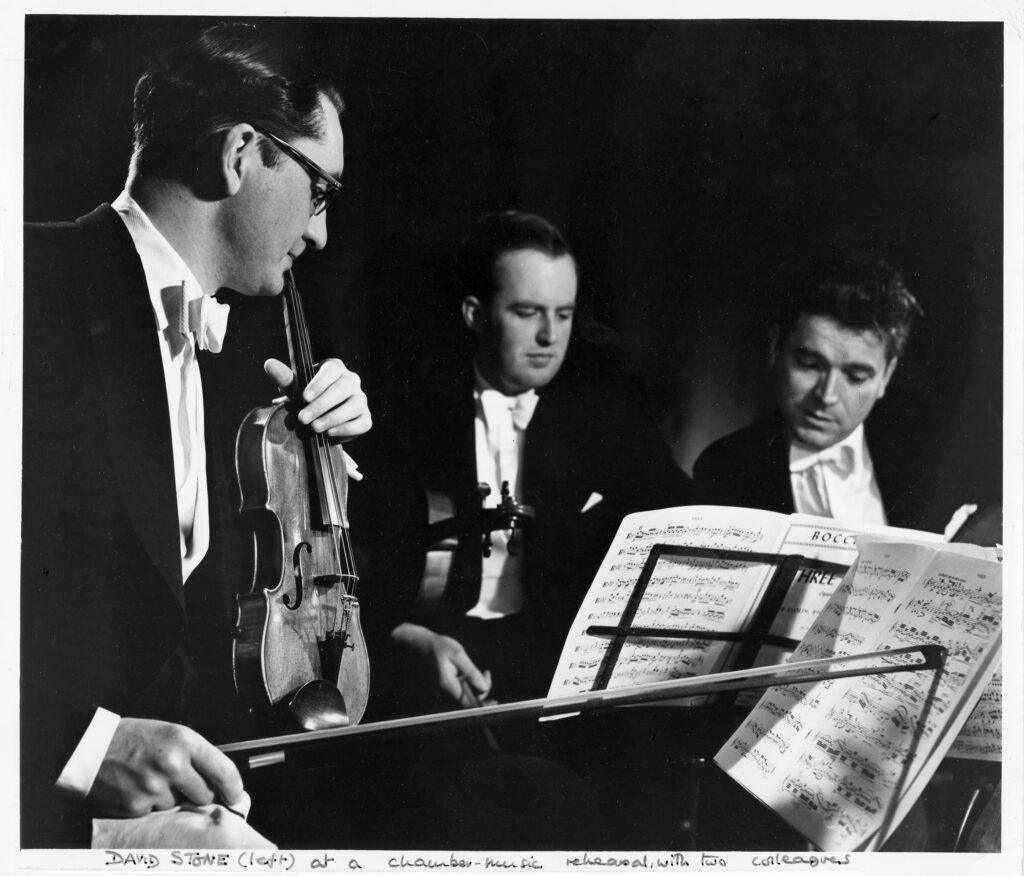New Zealand
At home in the Cotswolds, after graduating from Cambridge, David set out to define and fulfil his role in life, guided by his awareness that he was a musician with the ability to communicate. Ideally, he was looking for an initial post with an ensemble resident at a university. He waited some months before he was appointed as violinist in the String Trio, newly inaugurated by Vernon Griffiths, the visionary Professor of Music (with his motto ‘Music is Sound’), at the University of Canterbury at Christchurch, New Zealand. There, in 1958 he and his then wife arrived – to live on a farm in the Cashmere Hills with views of the Southern Alps. The post involved concertising, broadcasting and lecturing. (The work of the Trio helped pave the way for the eventual Christchurch Civic Orchestra and the Christchurch Opera House.) David also served as Lay Reader in the Anglican Church for a very committed congregation.

Over the three years of the residency he seized the opportunity to impose on himself a strict regime of technical development – muscular exercises, scales, studies and repertoire.
Frederick Delius
But it was in New Zealand that David was introduced to the sonatas of Frederick Delius by the elderly pianist Ernest Jenner MBE, who shared with David the secret of interpreting and mastering Delius’ individual rhythmic flow. Rehearsing together in Ernest’s isolated country cottage near the Rakaia Gorge, with its wild and colourful garden, David immediately discovered a strong affinity with Delius.
This led him in 1973 and 1974 to become the first artist to record all the Delius violin and piano works, Sonatas 2, 3 and Légende with Alan Schiller (nominated Record of the Month by Hi-Fi News & Record Review) and, with Robert Threlfall, the newly discovered manuscript of the hitherto unpublished 1892 Sonata in B and Sonata No. 1 (commissioned by the Delius Society, 1975). These recordings led to a revival of interest in these works.
“David Stone and Alan Schiller … convey more of the Delian rapture, more of the innermost poetry. Their approach is spacious and flexible, every nuance is made to tell and the overall effect is as sensitive as it is finely controlled. … something at last very like the Beecham touch; they let the music breathe and know exactly how to realize its essential magic …”
Hugh Ottaway, Hi-Fi News & Record Review, August 1975
“Again … congratulations. Pearl has issued another hell of a pearl!”
Frank Corsaro, American opera and theatre director who produced several Delius operas, 25 February 1975
“radiantly convincing … leaping exuberance”
Guardian, January 1976
David Martin Quartet and Menuhin Chamber Orchestra, London
In 1962, with his then wife and young son Jonathan, he briefly returned to his Leighterton home before, encouraged by Leonard Hirsch, to take up residence in London.
After two months he was leading a very full life as a freelance violinist with such ensembles as the English Chamber Orchestra, the Sinfonia of London (for the Dimitri Tiomkin film scores), the Philomusica and others, as well as doing deputy work in the theatre pit (for example, for My Fair Lady, starring Rex Harrison) – in other words, taking as many engagements as he could in order to learn the crafts of his profession, not only as a freelance violinist but also using the opportunity to play for and study such celebrated conductors as Bolt, Susskind, Fistolari, Kripps and many others. At the same time he was Visiting Lecturer in Violin at the universities of Sheffield and Reading. At the invitation of David Martin, Professor of Violin at the Royal Academy of Music, he joined the David Martin Quartet (at the time the longest-established British quartet other than the Amadeus), and with his own string Trio Pro Musica formed in 1963 he played with such artists as Léon Goossens, Franz Reizenstein, Marisa Robles and Maria Korchinska.

In 1964 David was invited to join the Menuhin Chamber Orchestra (originally the Bath Festival, later the Menuhin Festival Orchestra) where in due course he became Principal Second Violin, replacing Sidney Humphreys, taking part in worldwide tours, recordings and performances, including at Buckingham Palace and Windsor Castle. It was on one of the Orchestra’s tours (Hong Kong, New Zealand, Australia) in 1973 that they played at the Hong Kong Arts Festival. This was David’s first contact with Hong Kong, which was to figure so largely in his life; he commented to his family on his return that he felt a strong affinity with Hong Kong and had a premonition of a future role there.
“music-making of a quality we had never heard before and never will hear again”
Australian music critic on a performance in Sydney with the Menuhin Orchestra
During his years with the orchestra, he was privileged from time to time to share brief tête-à-tête moments of insight with Lord Menuhin.
“I have such a high regard for David Stone and treasure our long association.”
Yehudi Menuhin. Signed photograph given to David by Menuhin
Solo tours
As soloist, David toured the Middle East, Turkey, India, Malaysia, Sarawak, Hong Kong, Japan, Canada, the West Indies and the USA.
“Stone is an inspired and spontaneous violinist with more than a streak of greatness … as an example of intense musical communication, it was one of the most thrilling things I have heard”
Times of India, Mumbai, 1976


He has played and owned violins by Stradivarius, Nicolò Gagliano, Joseph Filius Andrei Guarnerius, and J.B. Rogerius, and he was loaned the Godard Stradivarius.
